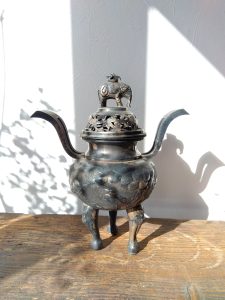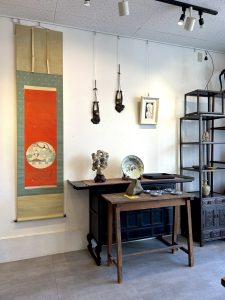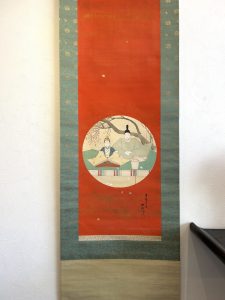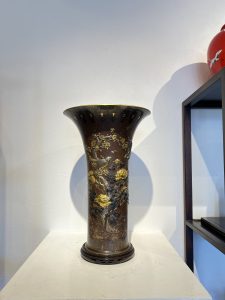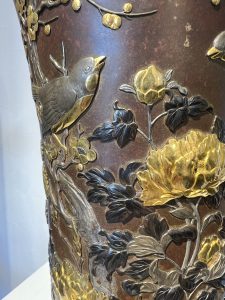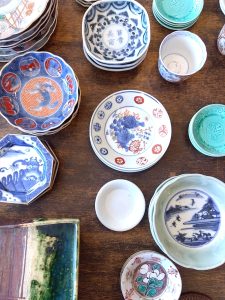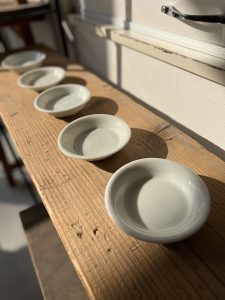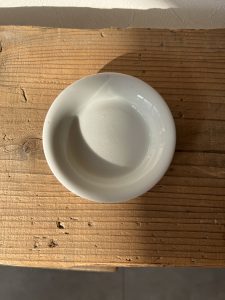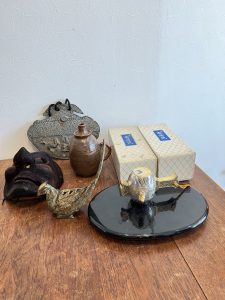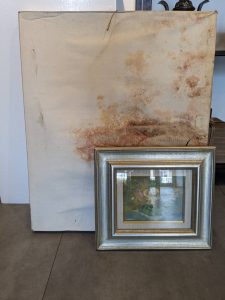南国から来た小さく愛らしい香合(愛知県名古屋市千種区姫池通 骨董買取 古美術風光舎)
2024.02.07
皆さまこんにちは。スタッフHでございます。
最近寒さで手がかじかんでいるのか、年齢のせいなのかよく物を落としてしまいます。食事の支度中にも箸や皿など派手に落とし家族に笑われております。やはり後者が原因の気がいたします。
店内の掃除の際にも、小さくて触る時に手が震えてしまう陶器がございます。直径4㎝高さ3㎝の小さくて愛らしい香合で、タイの宋胡録(すんころく)と呼ばれる焼き物です。「スンコロク」と聞いた時は耳慣れない音の響きに一瞬思考が止まってしまいましたが、タイの焼き物と知り納得しました。タイ語で知っているのは「サワッディーカー(こんにちは)」と「コップクンカー(ありがとう)」くらいですが、リズミカルで発音するのが楽しい言語だなと思っていました。
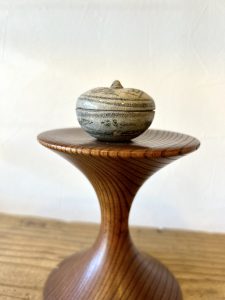

宋胡録(すんころく)とはタイの地名であるスワンカロークの音をそのまま漢字に変換したといわれています。タイの北中部、スワンカローク市の郊外のパーヤン村、ツターカ村、バン・コーノイ村には145か所ほどの古陶磁窯があり、その中心がスワンカローク窯とのことです。
スワンカローク焼の起源は13世紀といわれており、当時はスコータイ王朝の絶頂期でもありました。タイではそれまでは装飾性がなく、生活雑器として使われる地味な焼き物が主流でしたが、3代目カムヘーン王が中国から陶工を招き、鉄絵などの装飾技術を学び生まれたのがスワンカローク焼です。そのため中国の陶磁器の影響を強く受けており、青花や青磁を模し、胎土に白化粧を施し、そこに鉄絵や灰青磁釉で模様を描いた作品が多く見られるとのことです。
江戸時代前期の鎖国政策が行使されるまでの日本は、東南アジアを中心に盛んに貿易が行われていました。桃山時代や江戸初期に皿、鉢、蓋物などのスワンカローク焼が輸入され、その中でも小さくて素朴な温かみのある蓋物は茶人の間で人気となり、香合として見立てていたそうです。千利休も愛用していたとか。
その形状から「柿香合」と呼ばれる物もあり、風光舎にある宋胡録の香合の絵柄も柿のようにも見えます。しかし実際はこれらは柿を模して作られたものではなく、南国のフルーツ、マンゴスチンの果実を模したものだとか。当時の日本の人々がマンゴスチンを目にすることはそうそうなかったでしょうから、柿で正解としましょう。
余談ですが宋胡録が飾られている台は昔の枕として使われていいたものです。綺麗に結った髪が乱れないようこの高さ、この形状になっているのでしょうが、どう考えても熟睡できない気がいたします。
それでは、また次の機会に。
Hello everyone. This is Staff H.
Recently, I often drop things, perhaps because my hands get cold or because of my age. My family laughs at me when I drop things like chopsticks and plates while preparing meals. I think the latter is the cause.
When cleaning the restaurant, there is a small piece of pottery that makes my hands tremble when I touch it. It is a small and lovely incense container with a diameter of 4 cm and a height of 3 cm, and is called “Sungkorok” pottery from Thailand. When I heard the word “Sungkorok,” I stopped thinking for a moment because of the unfamiliar sound, but when I learned that it was Thai pottery, I was convinced. The only Thai words I know are “Sawadhikkar (hello)” and “Kopkunkkar (thank you),” but I thought it was a rhythmical and fun language to pronounce.
It is said that Sungkorok is the sound of Suwankarok, a place name in Thailand, directly converted into Chinese characters. There are about 145 old pottery kilns in the villages of Phayang, Tutthakha, and Bang Koh Noi in the suburbs of Suvankolok in north central Thailand, and the center of these kilns is the Suvankolok kiln.
The origin of Suvankarok ware is said to date back to the 13th century, which was also the peak of the Sukhothai dynasty at that time. Until then, the mainstream of Thai ceramics had been plain and unadorned, used as miscellaneous daily utensils, but King Kamphaeng the 3rd invited potters from China and learned decorative techniques such as iron painting, which gave birth to Suvankalok ware. Therefore, the influence of Chinese ceramics was strong, and many of the pieces were imitations of blue-and-white or celadon porcelain, with white glaze applied to the clay and patterns painted on it using iron painting or gray celadon glaze.
Until the policy of national isolation was exercised in the early Edo period (1603-1868), Japan was actively engaged in trade, especially with Southeast Asia. During the Momoyama period and early Edo period, plates, bowls, lids, and other types of suwankorok ware were imported, and among them, small, simple, warm lids became popular among tea masters, who used them as incense containers. It is said that Sen no Rikyu also used it as a favorite.
Because of their shape, some are called “persimmon incense containers,” and the design of the Songkoroku incense containers in the Fuhkosha also looks like a persimmon. In reality, however, they were not made to resemble persimmons, but rather the fruit of the mangosteen, a tropical fruit. Since Japanese people at that time would not have seen the mangosteen so often, the persimmon is the correct answer.
As a side note, the stand on which the Songkoroku is displayed was used as a pillow in the old days. The height and shape of the pillow is probably designed to keep the hair in a neatly tied bun from being disheveled, but I don’t think I would be able to sleep soundly on it.
I will see you next time
*******************
ご実家の整理やお片付けなどをされている方のご相談などが多くございます。
お片付けなどくれぐれもご無理のないようになさってくださいませ。
風光舎では古美術品や骨董品の他にも絵画や宝石、趣味のお品など様々なジャンルのものを買受しております。
お片付けをされていて、こういうものでもいいのかしらと迷われているものでも、どうぞお気軽にご相談下さいませ。
また風光舎は、出張買取も強化しております。ご近所はもちろん、愛知県内、岐阜県、三重県その他の県へも出張いたします。
まずは、お電話お待ちしております。
愛知県名古屋市千種区姫池通
骨董 買取【古美術 風光舎 名古屋店】
TEL052(734)8444
10:00-18:00 OPEN
#骨董買取#古美術買取#出張買取#無料査定#生前整理#遺品整理#家じまい#実感じまい#掛け軸#絵画#木箱入り茶碗#刀剣#洋食器#貴金属

